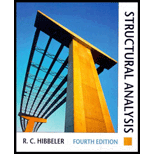Sorry! We don’t have solutions for this edition yet.
Solutions are available for other editions of this book
View 10th Edition solutionsarrow_forwardBook Details
This book provides students with a clear and thorough presentation of the theory and application of structural analysis as it applies to trusses, beams, and frames. Emphasis is placed on teaching students to both model and analyze a structure. A hallmark of the text, Procedures for Analysis, has been retained in this edition to provide students with a logical, orderly method to follow when applying theory.
NEW--Approximately 15% NEW problems.
Example problems demonstrate the application of theory to practical engineering problems.
NEW--Project Problems that involve realistic structural systems. These projects will give students a sense of what is required to model and then analyze an actual structure.
Photographs of the structure will be given.
The determination of the loads will be required.
The members will have to be represented by an idealized model.
The theory will be applied to obtain the reactions and construct the shear and moment diagrams.
NEW--Over 100 photographs dispersed throughout the book present the solution of realistic applications and explanations of the theory. Some of these photos are used in the problem sets.
NEW--Expands Chapter 1 on loadings to include a more detailed discussion of loadings.
NEW--Includes a simple analysis of shear wall loadings.
NEW--Enhances the use of the computer program STRAN from previous editions to include the construction of shear and moment diagrams for frames. The program is easy to understand and use, and works in a Windows environment, rather than in DOS.
NEW--Expanded coverage of the matrix stiffness method.
NEW--Uses STRAN, or any other suitable structural analysis program, as a means to check the solutions of the problems. This encourages the student to consider computer applications earlier in the course, rather than at the end, when the Stiffness Method is covered.
Features exceptional illustrations, photographs, and design elements to enhance the realism of examples, homework problems, and explanations.
Includes Procedures for Analysis in most sections of the text, along with example problems illustrating the procedures, to provide a logical, method for students to follow when applying the theory presented in each section.
Depicts realistic engineering situations that students are likely to encounter in practice. The problems are clearly illustrated to show the necessary geometric relations and loads.
More Editions of This Book
Corresponding editions of this textbook are also available below:
